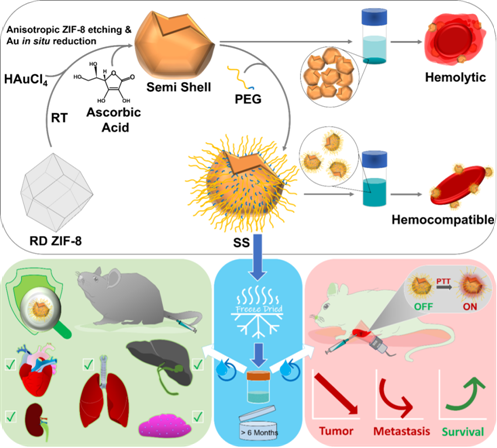Revolutionary One-Step Nanoparticle Synthesis Boosts Photothermal Cancer Therapy
At the heart of this innovation lies the strategic use of a rhombic dodecahedron-shaped metal-organic framework (MOF), specifically ZIF-8, as a sacrificial template.

- Country:
- India
In a significant leap for cancer nanomedicine, researchers in India have developed a groundbreaking one-step colloidal synthesis method to fabricate innovative nanoparticles with a semi-shell (SS) nano-cup morphology, dramatically simplifying the fabrication process for photothermal therapy (PTT). This new technique promises to revolutionize targeted cancer treatment by enabling minimally invasive, highly efficient thermal ablation of tumors with enhanced safety, stability, and therapeutic efficacy.
Breakthrough by Indian Research Collaborators
The pioneering study was conducted by a team from the Institute of Nano Science and Technology (INST), Mohali—an autonomous body under India’s Department of Science and Technology (DST)—in collaboration with the Advanced Centre for Treatment, Research & Education in Cancer (ACTREC) under Tata Memorial Centre, and the Indian Institute of Technology Bombay (IITB). Their results were recently published in Communications Chemistry, an open-access journal of the Nature Publishing Group.
This novel synthesis route circumvents many long-standing challenges associated with conventional SS fabrication, such as complex multi-step procedures, high-temperature conditions, and toxic chemicals like hydrofluoric acid. The team’s one-step synthesis not only reduces processing time and cost but also ensures greater environmental and biological compatibility.
Engineering Semi-Shells: The Role of MOF Templates and PEGylation
At the heart of this innovation lies the strategic use of a rhombic dodecahedron-shaped metal-organic framework (MOF), specifically ZIF-8, as a sacrificial template. These MOFs are known for their structural tunability and biocompatibility. During the synthesis, the ZIF-8 structures are gently etched using ascorbic acid (Vitamin C) at room temperature—a much milder approach compared to traditional etching techniques—while gold nanoparticles simultaneously form in situ.
This concurrent etching and nanoparticle growth gives rise to the semi-shells with unique nano-cup morphology. Their optical properties are further enhanced by their ability to strongly absorb and scatter light in the near-infrared (NIR) spectrum, which is ideal for deep tissue photothermal applications.
To improve blood compatibility and aqueous stability, the SS structures are surface-modified with polyethylene glycol (PEG), a widely accepted biocompatible polymer. PEGylation endows these nanoparticles with cryopreservability, systemic safety, and a prolonged shelf life—essential attributes for clinical translation.
Photothermal Therapy: A Leap in Breast Cancer Treatment
Photothermal therapy (PTT) uses photo-absorbing agents to convert NIR light into localized heat, selectively killing cancer cells while sparing healthy tissue. The newly developed PEGylated SS demonstrated exceptional photothermal conversion efficiency, leading to effective tumor ablation in preclinical models.
In mouse models with advanced metastatic breast cancer, the SS-based PTT treatment not only successfully destroyed tumors but also significantly improved survival rates and reduced the risk of tumor recurrence. This marks a promising advancement over existing PTT agents, which often suffer from low stability, limited tissue penetration, or toxicity.
Advantages Over Existing Technologies
Compared to current PTT nanoplatforms, this novel approach offers several advantages:
-
Single-step synthesis avoids harsh chemicals and complex machinery.
-
Room temperature processing ensures scalability and cost-effectiveness.
-
PEG surface modification enhances biocompatibility and clinical readiness.
-
NIR-active SS design offers precise, deep tissue photothermal ablation.
-
High stability and low toxicity ensure minimal side effects during systemic administration.
Future Outlook: Toward Multi-Modal Cancer Therapies and Advanced Diagnostics
Building on this success, the research team plans to investigate the use of these semi-shells for chemo-photothermal therapy (combining chemotherapy and PTT), potentially delivering dual-action cancer treatment with higher specificity and reduced side effects.
Furthermore, their unique optical characteristics make the SS nanoparticles excellent candidates for Surface-Enhanced Raman Spectroscopy (SERS), a sensitive technique for detecting molecular signatures. This opens new possibilities in cancer diagnostics, biosensing, and image-guided therapy.
The team’s work represents a convergence of nanotechnology, materials science, and oncology, aiming to bridge the gap between laboratory research and real-world medical applications. If future clinical studies confirm their preclinical promise, these one-step synthesized semi-shells could mark a paradigm shift in the way cancer is treated—especially in resource-limited settings.










